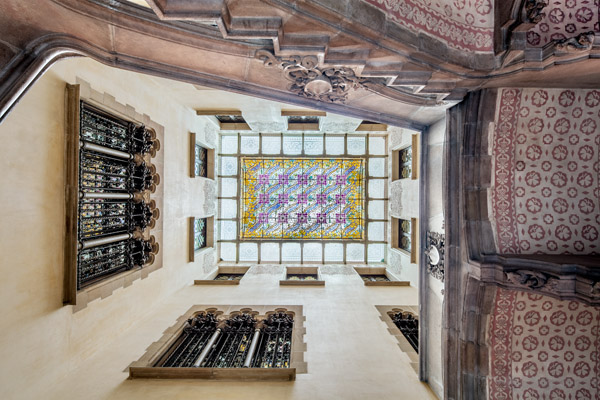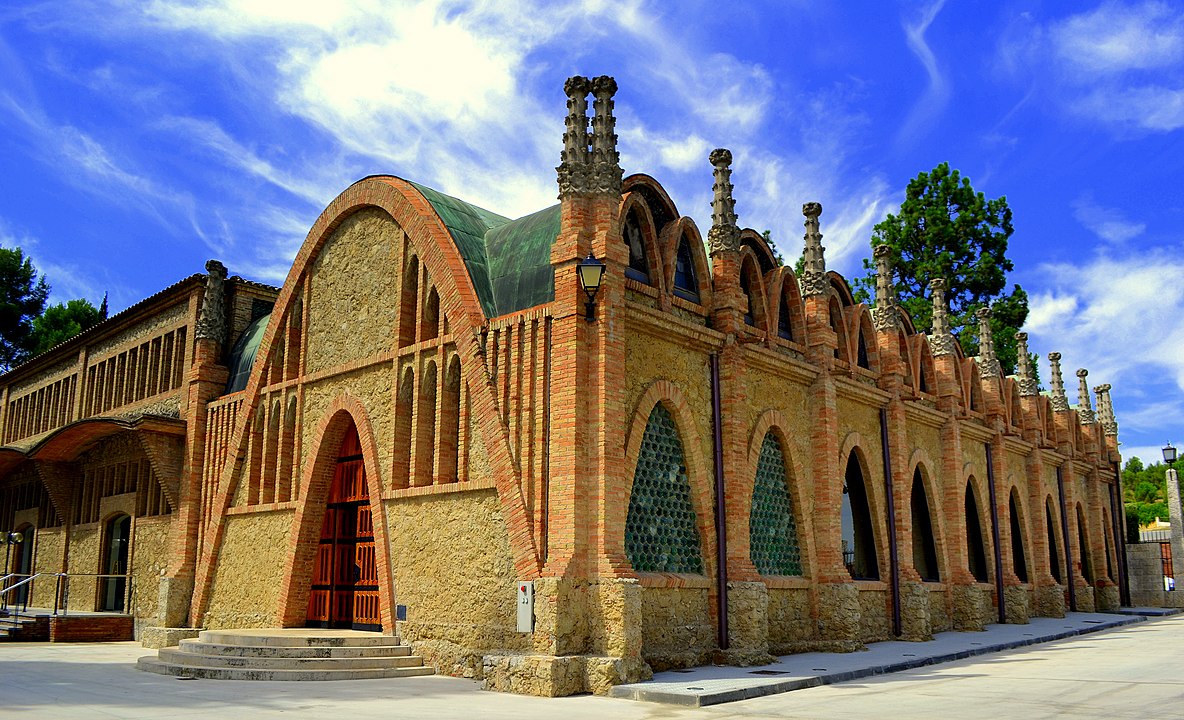10 works by the modernist architect Puig i Cadafalch on his anniversary
The architect Josep Pugi i Cadafalch was born on 17 October 1867 in Mataró. In the Casa Museu Amatller, in which he took part with an innovative project, we recognise him as one of the great figures of Catalan Modernist architecture.
Throughout his life we find two other facets that extol the name of Puig i Cadafalch: research into the History of Art (it was he who defined the importance of Catalan Romanesque architecture, "discovering" the monuments of the first Romanesque in Vall del Boí and Vall d'Aran); and political representation (he became the successor of Prat de la Riba as president of the Mancomunitat de Catalunya, although the dictatorship of Primo de Rivera removed him from his post).
To commemorate the anniversary of Josep Puig i Cadafalch we would like to take a look at a selection of ten works from his extensive architectural production. We are also going to relate each of these constructions with what was one of his first masterpieces, the Casa Museu Amatller. Will you join us?
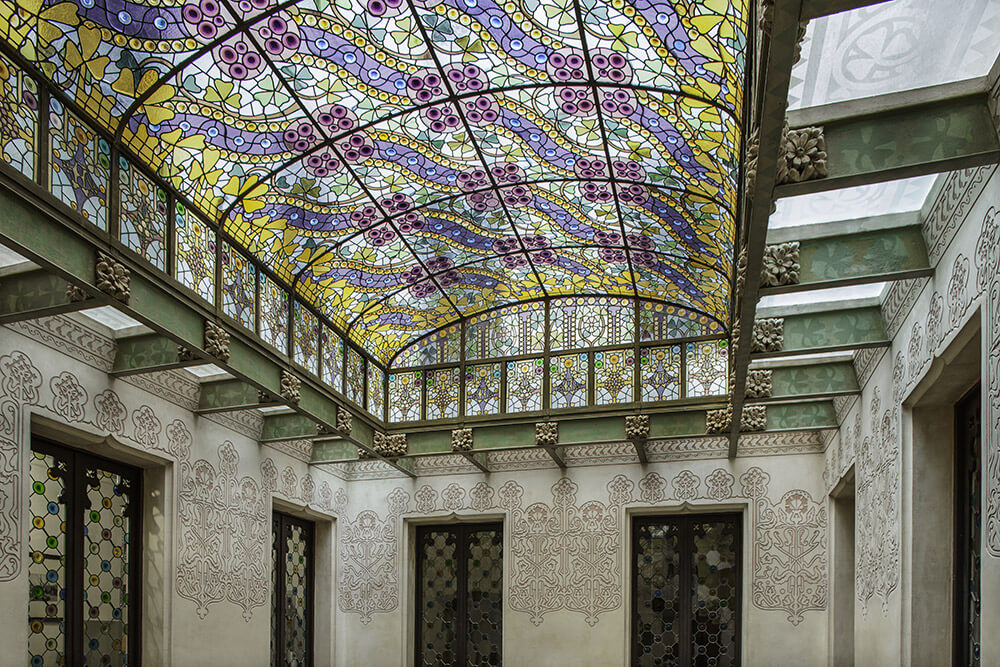
La arquitectura de Puig i Cadafalch en 10 obras:
- Casa Sisternes, 1891 Mataró. It is recognised as Puig i Cadafalch's first work. In it the architect already resorts to the decoration of tiles and wrought iron.
- Casa Martí, 1896. Els Quatre Gats. Here you can see obvious neo-Medieval airs, mainly Gothic. There is also a large side tribune.
- Casa Coll i Regàs, 1897. Here Puig i Cadafalch takes decorativism to the limit and includes a stepped pediment in the ornamentation. What does this decorative resource sound like to you?
- Palau Macaya, 1898-1901. Although the decoration is softened, the monumentality of the palatial remains, with a large interior courtyard and staircase with an infinite number of details.
- Casa Muntades, 1901. A single-family house that reinterprets the Baroque conception of popular Catalan architecture.
- Casa Serra, 1903. Today it is the Diputació de Barcelona. Although it has been greatly transformed in later performances, the sculptural decoration of Eusebi Arnau, the sculptor who usually works with Puig i Cadafalch, stands out.
- Palau del Baró de Quadras, 1904-1906. The Neo-Gothic style connects contemporary nobility with the medieval world.
- Casa de les Punxes, 1905. Once again Puig i Cadafalch takes us to a medieval world, almost fantasy, with its large pointed towers.
- Fábrica Casaramona, 1909-12. It is an industrial construction, where the modernist language is put at the service of the industrial use. The exposed brick is in charge of giving beauty to this work.
- Quatre Columnes, 1919. The present ones are a reconstruction. They are a symbol of Catalanism, a tribute to the four bars of the Senyera.

Casa Amatller as part of Puig i Cadafalch's architectural production
The elements that developed throughout Puig i Cadafalch's production and that we have seen in ten works, also appear in the Casa Museu Amatller. Let's check it out.
The industrial chocolate maker Antoni Amatller promoted its construction so that it would become the family home. Both Mr. Amatller and Puig i Cadafalch had deep Catalanist convictions, which is why such identifiable symbols as the Saint George with the dragon at the entrance appear, which also appear in other works, such as the Casa de les Punxes.
The Casa Museu Amatller is one of the first houses in Puig i Cadafalch with the appearance of a medieval palace, with an interior courtyard with a staircase leading up to the main floor. It shares it with the Palau Baró de Quadras or the Palau Macaya.
Other aspects that are also repeated in Casa Amatller and throughout Puig i Cadafalch's work are the goticist airs of the decoration, the existence of grandstands with enormous decoration and the use of materials such as forge and ceramics for decoration. The artists also repeat themselves, with the sculptor Eusebi Arnau working on many works by Puig i Cadafalch.
After reviewing some of Puig i Cadafalch's architectural, decorative and spatial elements that are also to be found in the Casa Museu Amatller, we must remind you that the Amatller family's house is incredible: it is the only modernist house that conserves its original modernist decoration and architecture. It always surprises on every visit with its journey to 1900!
Do you also come to be amazed? Choose your entrance to see the Amatller House Museum!
The animals of Casa Museu Amatller
The Casa Museu Amatller, the fascinating house promoted by the chocolate maker Antoni Amatller, shows some of the characteristics of the architecture of Catalan Modernism. In its spaces we see the medieval inspiration, the use of materials such as stucco or tiles and a large ornamental display, which in most cases takes as a reference to the natural world.
In addition, Casa Museu Amatller, more than a conventional dwelling, appears as a total work of art. In its construction, the architect Josep Puig i Cadafalch had artists and craftsmen at his service to complete the decoration of Antoni Amatller's house.
One of the artists who worked with Puig i Cadafalch was the sculptor Eusebi Arnau, the most outstanding of Catalan Modernism. He was in charge of sculpting an entire complex sculptural programme, with multiple figures full of meaning. In another article and we had commented how the façade of the Casa Museu Amatller presented a careful symbolism aimed at showing passers-by who Antoni Amatller and his family were. Therefore, the reliefs and statues had a lot to say.
Today we want to explain to you how the Casa Museu Amatller has a large number of animal figures inside, on its façade and in the hall. Are you coming to see them all?
Animals in the decoration of the façade of Casa Amatller
Let's start at the foot of the street, looking at the spectacular façade of Casa Amatller with its incredible stepped triangular pediment. Let's look at the balcony on the main floor. Here we find capitals with animals performing human actions. The activities of these figures respond to the symbols on the coats of arms found on the lintels of the balcony windows.
In the left window, the capitals show some rabbits working with iron and some monkeys using the anvil, symbol of the industry; in the central window we can see some dogs with a camera of photos of the time and some donkeys with books, reading glasses and Cervantine lechuguilla, that represent the arts and the photography; finally, in the right window some piglets manipulate the ceramics and some frogs are with the blown glass, symbolizing the activity of Antoni Amatller as collector of glass of the Antiquity.
Around the entrance door to the building there are two lions supporting the coat of arms that shows a "1900", the year the Casa Amatller was completed; and a capital where a gypsy controls a bear with a rope.
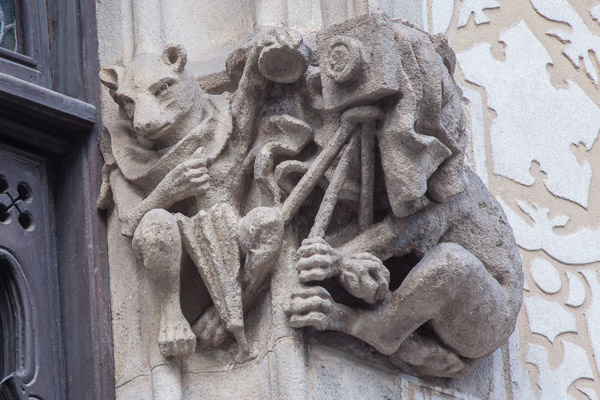
Animals in the lobby of Casa Amatller
If we advance towards the interior, in the vestibule we have a series of figures with the body of a person and the head of an animal (birds, squirrels, monkey, frog...). They are in charge of making chocolate, the origin of the Amatller family's fortune, in their processes: from collecting the cocoa to placing the chocolate on the bar.
There are more animals in the space that illuminates the incredible stained glass window. A parrot at the foot of the staircase holds the Amatller coat of arms with its beak. And if we go up the steps we reach the entrance door to the main floor, with two small animals on the sides, which sound their instruments to welcome us.

The animals inside the Casa Museu Amatller
Inside home of the Amatller family we can discover more animals, all with a meaning that has to be read in function of the values associated to the dynasty of chocolatiers or to the person who inhabits each room. For example, on one of the dining room doors there is a spider that is going to eat a fly that has fallen into the web. It is a symbol of the collection of profits, of the reward for having invested time in work that bears fruit in the long term.
Entering into the private part of the house we will see animals at the entrance door of Teresa Amatller's bedroom: accompanying a woman who sews, a cat appears playing with a ball and a dog. They are symbols of fidelity, a virtue that was expected for a woman of the time.
Meanwhile, on the other side of the house, the access to Antoni Amatller's bedroom is flanked by two groups of sculptures: a heron with a bag of money, representing the control of the economy exercised by the patron of the home; and a pair of owls, symbol of the constant vigilance required to make profits in his company.

Monkeys, spiders, bears, lions, cats, dogs, birds...an enormous zoo world unfolds throughout Casa Amatller and is perfectly represented in the sculptures of the modernist artist Eusebi Arnau. On another occasion we will have to stop at all the fantastic animals that we meet on the visit, such as dragons. What have you also noticed?
Meanwhile, we would love for you to visit the Casa Museu Amatller and marvel at all the animals that live in the modernist house. Choose your entrance here and your way of visiting!
The animals of Casa Museu Amatller
The Casa Museu Amatller, the fascinating house promoted by the chocolate maker Antoni Amatller, shows some of the characteristics of the architecture of Catalan Modernism. In its spaces we see the medieval inspiration, the use of materials such as stucco or tiles and a large ornamental display, which in most cases takes as a reference to the natural world.
In addition, Casa Museu Amatller, more than a conventional dwelling, appears as a total work of art. In its construction, the architect Josep Puig i Cadafalch had artists and craftsmen at his service to complete the decoration of Antoni Amatller's house.
One of the artists who worked with Puig i Cadafalch was the sculptor Eusebi Arnau, the most outstanding of Catalan Modernism. He was in charge of sculpting an entire complex sculptural programme, with multiple figures full of meaning. In another article and we had commented how the façade of the Casa Museu Amatller presented a careful symbolism aimed at showing passers-by who Antoni Amatller and his family were. Therefore, the reliefs and statues had a lot to say.
Today we want to explain to you how the Casa Museu Amatller has a large number of animal figures inside, on its façade and in the hall. Are you coming to see them all?
Animals in the decoration of the façade of Casa Amatller
Let's start at the foot of the street, looking at the spectacular façade of Casa Amatller with its incredible stepped triangular pediment. Let's look at the balcony on the main floor. Here we find capitals with animals performing human actions. The activities of these figures respond to the symbols on the coats of arms found on the lintels of the balcony windows.
In the left window, the capitals show some rabbits working with iron and some monkeys using the anvil, symbol of the industry; in the central window we can see some dogs with a camera of photos of the time and some donkeys with books, reading glasses and Cervantine lechuguilla, that represent the arts and the photography; finally, in the right window some piglets manipulate the ceramics and some frogs are with the blown glass, symbolizing the activity of Antoni Amatller as collector of glass of the Antiquity.
Around the entrance door to the building there are two lions supporting the coat of arms that shows a "1900", the year the Casa Amatller was completed; and a capital where a gypsy controls a bear with a rope.

Animals in the lobby of Casa Amatller
If we advance towards the interior, in the vestibule we have a series of figures with the body of a person and the head of an animal (birds, squirrels, monkey, frog...). They are in charge of making chocolate, the origin of the Amatller family's fortune, in their processes: from collecting the cocoa to placing the chocolate on the bar.
There are more animals in the space that illuminates the incredible stained glass window. A parrot at the foot of the staircase holds the Amatller coat of arms with its beak. And if we go up the steps we reach the entrance door to the main floor, with two small animals on the sides, which sound their instruments to welcome us.

The animals inside the Casa Museu Amatller
Inside home of the Amatller family we can discover more animals, all with a meaning that has to be read in function of the values associated to the dynasty of chocolatiers or to the person who inhabits each room. For example, on one of the dining room doors there is a spider that is going to eat a fly that has fallen into the web. It is a symbol of the collection of profits, of the reward for having invested time in work that bears fruit in the long term.
Entering into the private part of the house we will see animals at the entrance door of Teresa Amatller's bedroom: accompanying a woman who sews, a cat appears playing with a ball and a dog. They are symbols of fidelity, a virtue that was expected for a woman of the time.
Meanwhile, on the other side of the house, the access to Antoni Amatller's bedroom is flanked by two groups of sculptures: a heron with a bag of money, representing the control of the economy exercised by the patron of the home; and a pair of owls, symbol of the constant vigilance required to make profits in his company.

Monkeys, spiders, bears, lions, cats, dogs, birds...an enormous zoo world unfolds throughout Casa Amatller and is perfectly represented in the sculptures of the modernist artist Eusebi Arnau. On another occasion we will have to stop at all the fantastic animals that we meet on the visit, such as dragons. What have you also noticed?
Meanwhile, we would love for you to visit the Casa Museu Amatller and marvel at all the animals that live in the modernist house. Choose your entrance here and your way of visiting!
The rupture of Casa Amatller with the Plan Cerdà, creator of the Eixample of Barcelona
Casa Amatller must be valued as something more than the precious work of Catalan modernist architecture that it is. The work of Josep Puig i Cadafalch, one of the great referents of Modernism in Catalonia together with the most famous Antoni Gaudí and Lluís Doménech i Montaner, constitutes a true milestone in Barcelona's urbanism.
Let's do a bit of history and put ourselves on the map, literally. In the 1860s the Cerdà Plan began to be executed, a project designed by the engineer Ildefons Cerdà to organise the new streets to be opened in Barcelona's Eixample. The most recognisable part of the plan was the orthogonal layout of the roads and a unitary structure of blocks with chamfers to accommodate the city's growing traffic. However, there are some details of the Eixample that are not so well known. For example, Cerdà's plan specified that the facades of this new area of Barcelona should have a height limit and a discreet decoration, in the neoclassical stylistic line dominant in the central years of the 19th century. All the buildings in the city more or less followed these guidelines, with the only exceptions of public buildings such as churches, hospitals or schools. Private houses maintained Cerdà's criteria until the Casa Amatller appeared in 1898.
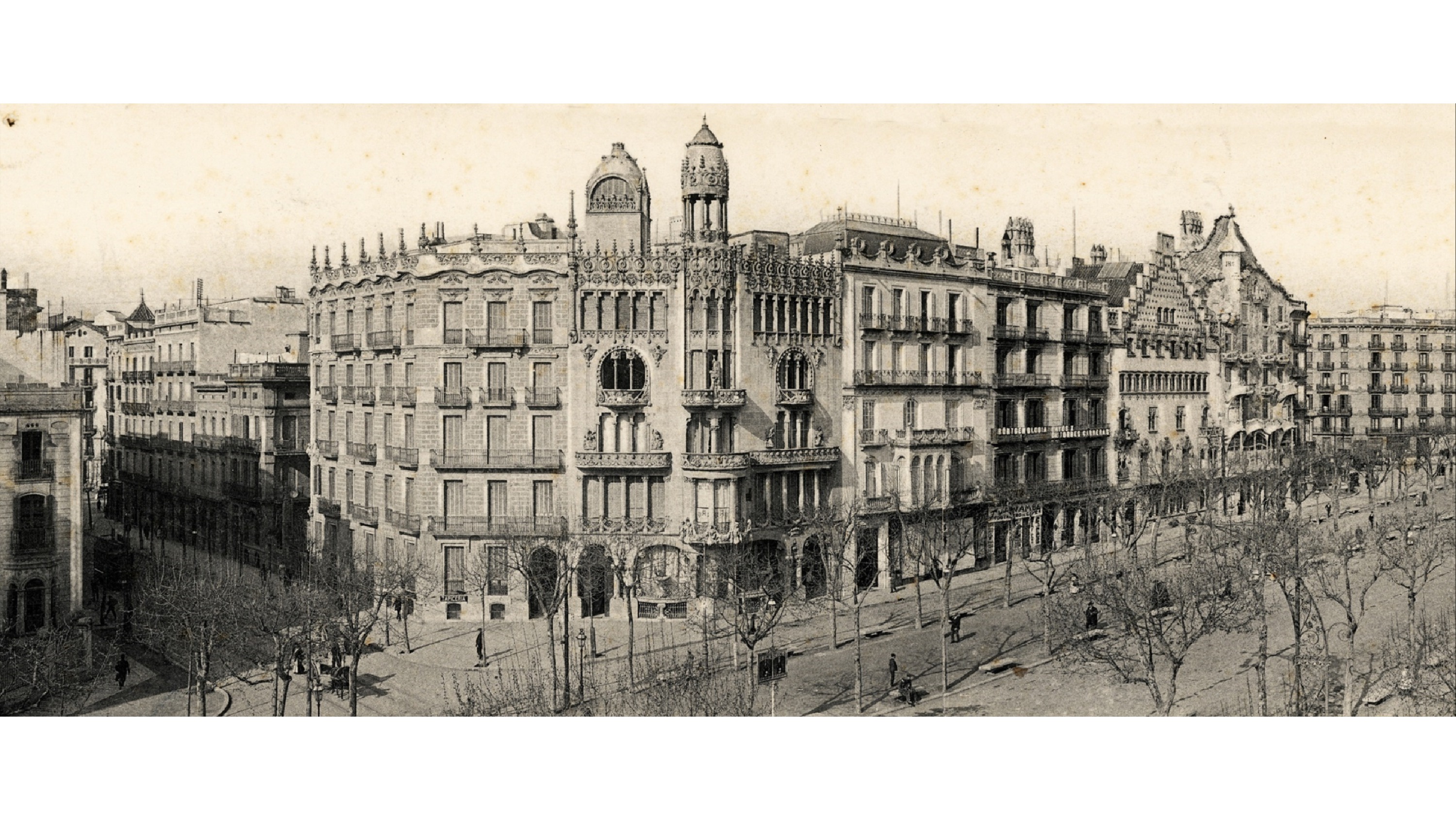
Antoni Amatller había triunfado profesionalmente con su actividad de empresario chocolatero. Se había comprado una casa en el Passeig de Gràcia y le pide a Puig i Cadafalch, por entonces un joven arquitecto que se iniciaba en la arquitectura del Modernismo catalán, que reforme este sobrio edificio. La feliz conexión entre el promotor y el arquitecto crea un edificio rompedor en el que era justo el centro neurálgico de Barcelona. Por un lado, consiguen elevar la fachada de la casa con un truco constructivo, la inclusión de un frontón triangular que sube unos metros la fachada. Por otro lado, se desarrolla todo un programa decorativo donde se combinan azulejos de colores, esculturas en piedra, columnas llenas de detalles y piezas de hierro forjado que no dejó indiferente a ningún barcelonés del año 1900.
La Casa Amatller fue entonces el primer edificio privado del Eixample que da la espalda al Plan Cerdà. A partir de su construcción otras personalidades de la arquitectura del Modernismo catalán, como Gaudí o Domènech i Montaner, comienzan a edificar otras casas para los burgueses locales, siguiendo las nuevas modas estilísticas. Es lo que sucede en la Manzana de la discordia, pero eso es otra historia.
Antoni Amatller had triumphed professionally with his activity as a chocolate businessman. He had bought a house in Passeig de Gràcia and asked Puig i Cadafalch, at that time a young architect who was starting out in Catalan Modernist architecture, to reform this sober building. The happy connection between the developer and the architect creates a groundbreaking building in what was just the nerve centre of Barcelona. On the one hand, they manage to elevate the façade of the house with a constructive trick, the inclusion of a triangular pediment that raises the façade a few metres. On the other hand, a whole decorative programme is developed combining coloured tiles, stone sculptures, columns full of details and pieces of wrought iron that did not leave any Barcelonaer indifferent in the year 1900.
Casa Amatller was then the first private building in the Eixample to turn its back on the Cerdà Plan. After its construction, other personalities of Catalan Modernist architecture, such as Gaudí or Domènech i Montaner, began to build other houses for the local bourgeoisie, following the new stylistic fashions. This is what happens in the Apple of Discord, but this is another story.
So every time you admire the modernist façade of Casa Amatller, remember that beneath all its beauty there is a history of constructive change in Barcelona. Have you known all its secrets yet?
The journey to Egypt in Antoni Amatller's photographs
Antoni Amatller, a travelling photographer
The life of Antoni Amatller, the chocolate industrialist who commissioned the Casa Amatller from the architect Josep Puig i Cadafalch, was truly surprising. For those of you who don't know it, you'd think it was a boring bourgeois who was able to build his beautiful house thanks to the money obtained from the family business, the successful Amatller Chocolates.
However, Antoni Amatller was a man with many hobbies, some of which made him ahead of his time. That he was a collector of art and archaeological glass was within the expectations of a person of his status. But that he liked photography, with a skilful handling of the camera thanks to which he received several awards, was already something exceptional. In addition, he was an outstanding traveler, also to destinations quite exotic for his time.
As heir to a renowned company, his father and uncle had promoted Antoni Amatller's business trips from a very young age. Every year novelties arose regarding industrial production and product sales strategies, so it was necessary to know them first hand in order to stay ahead of the competition in Spain. So I already had travel experience, but more from the point of view of business and old Europe.
Antoni Amatller entered more unknown territories, far removed from Western civilization. With his daughter Teresa Amatller he arrived in Egypt, Morocco or Istanbul between 1900 and 1910. At the beginning of the 20th century, long before the arrival of globalisation, they were exotic countries and, to a certain extent, not yet linked to the major tourist routes.

A journey to Egypt through the eyes of Antoni Amatller
Another pleasant surprise is that Antoni Amatller became a contemporary tourist. Because he was accompanied by his camera, which was not a comfortable modern tool but a camera of great equipment. His snapshots reveal his journey, with a visit to the most emblematic monuments of the place.
Now, the Fundació Institut Amatller d'Art Hispànic and B The Travel Brand Xperience are jointly organising an exhibition with a selection of the best photographs of this trip, "Egypt 1909: the trip of the Amatller family in the land of the Pharaohs". The exhibition is open in the exhibition hall of B The Travel Brand Xperience in Barcelona, at Avenida Diagonal 512. In them you can observe the splendid past of Pharaonic Egypt, the images in the different means of transport to the destination or the characteristics of life in Egypt at the beginning of the 20th century. The room also displays the memories of this trip in a display case, such as a guidebook or statuettes from Ancient Egypt.

Activities around the exhibition of Egypt 1909
To complement the exhibition, the "Passejades Amatller" have been created, combining a visit to the Casa Museu Amatller and the photographic exhibition. You can buy the tickets at this link.
In addition, we have also prepared a series of lectures by experts in which we will talk about Egyptology, the journeys and adventurers who approached the civilisation of the Nile, or the photographic facet of Antoni Amatller.
We hope that you too will enjoy this walk through Egypt with Antoni Amatller's snapshots!
Hidden treasures of Casa Amatller: the Friso dels Segadors
Antoni Amatller was aware of the enormous artistic value of his home, Casa Amatller, long before it was recognised as one of the best houses in Catalan Modernist architecture. We have received photographs of the main rooms of Casa Amatller in its early years, as Puig i Cadafalch had photographic reports made of its buildings. The chocolate industrialist was also aware of the documentary value of photography and we are sure that he was proud of his home.
Thanks to these old photographs and the extraordinary conservation of the furniture and decorative elements, the restoration at the beginning of the decade of 2010 was able to return the Casa Museu Amatller to a state as similar as it was at the beginning of the 20th century. Thus, it is possible to say that Casa Amatller is the only modernist house in Barcelona that maintains its original appearance of 1900, when the businessman lived there with his daughter Teresa. However, there are details in the images from the beginning of the century that cannot be appreciated, so in the restoration of 2010-15 there have been some surprises. As in the Sala de la Música, located in the public part of the Casa Amatller.
At the top of the walls, just under the incredible coffered ceiling, restaurateurs found a frieze with popular Catalan stanzas written in Gothic characters. One of them is the beginning of the Catalan national anthem, Els Segadors, in its original version, reworked at the end of the 19th century. The other is the Cançó del Mariner, a composition from the modern period.
These letters marked Catalanist values that corresponded to the personality of the housing developer, the chocolate industrialist Antoni Amatller, and the modernist architect Josep Puig i Cadafalch. Both were protagonists of the current that, in addition to highlighting Catalonia's own culture, demanded a political protagonism. The involvement of Puig i Cadafalch, who was the second president of the Mancomunitat, stands out.

We do not know exactly when or why these stanzas were covered up, but we can imagine it: because of its eminently Catalanist character, especially in relation to the hymn - "Catalunya triomfant..."- they were surely removed from view in 1939. At the beginning of this year the Civil War front was in Barcelona, with the Francoist army about to take over the city of Barcelona. A time was approaching in which nationalist parties, Catalan and any hint of Catalanism would be banned. So, seeing the difficult panorama that arrived, it is very probable that it was used at this moment to cover some texts that linked the owner, Teresa Amatller, with the Catalan and Catalanist tradition. Today, fortunately, it has been possible to recover this piece of heritage so that we can enjoy its beauty and the history it tells.
All the old buildings keep secrets, many of which are lost in time. In the Casa Museu Amatller the restoration work has allowed some of them to be brought to light, which also speak of a terrible period in the history of our country.
After decades of being hidden, today the verses resonate again for all visitors of the spectacular modernist house.
Happy Diada de Catalunya from Casa Museu Amatller!
What to visit in August in Barcelona?
Barcelona's cultural leisure does not go on holiday. In August, despite the fact that many of its inhabitants escape to other coastal enclaves or more distant parts of the world, there is still a lot to do, to get to know and to live in Barcelona.
From Casa Museu Amatller we want to remind you what to visit in August in Barcelona. To begin with, the modernist house that the architect Josep Puig i Cadafalch built for the industrial chocolate maker Antoni Amatller is still open to everyone.
In this article you will find 31 proposals, most of them related to the love we profess for art and heritage at Casa Museu Amatller. You have a different activity for each day of the month!
- The Modernist Nights at Casa Museu Amatller. Every Thursday you can travel to the bourgeois domestic life of 1900. In a great theatrical visit you will discover an authentic modernist house at the hands of its owner, Teresa Amatller.
- The Palau Macaya. On Mondays this palace designed by Puig i Cadafalch is visited by the hand of Cases Singulars. Get to know this building built at the same time as the Casa Museu Amatller!
- Noches con Ritmo de Casa de les Punxes. Every Friday the terrace of this monumental building in Puig i Cadafalch is filled with music.
- The works of Jujol in the Palau Güell. The amazing palace created by Antoni Gaudí in the heart of Raval between 1886 and 1890 is completed with a magnificent exhibition. "Jujol, architecture of colour" presents original objects designed by the architect Josep Maria Jujol, which helps us to understand the quality of the modernist work of this creator.
- Magic Nights in Casa Batlló. He climbs the Antoni Gaudí building every night to enjoy a concert of music of various genres after visiting the construction that has reopened its façade after the restoration.
- Palau de la Música Catalana. The only modernist concert hall in the world, designed by Domènech i Montaner, continues with its schedule of visits and its programme of events.
- Picasso Museum. If the museum's collection is unbelievable, the two temporary exhibitions somehow connect with Casa Amatller: one is dedicated to photography, one of Antoni Amatller's hobbies; the other to the family, an essential root for building the legacy of the Amatller family.
- Chocolate in Casa Museu Amatller. No one is bitter about a sweet, even when the temperature is high. Each visit to the modernism of our house ends with a cup of chocolate.
- Maritime Museum. Culture is also close to the sea, with the history of the great ships, perfectly replicated within the old shipyards, and maritime trade around the world.
- Museu Del Disseny. This spectacular building houses a collection of design from various periods. Did you know that you can find objects from the modernist period or dresses that could have been by Teresa Amatller?
- CCCB with "Feminismes! In the Casa Amatller there was an independent woman like Teresa Amatller, who was in charge of the family business and the patrimony of her house for 50 years. At the CCCB the works in the exhibition Feminismes! vindicate the role of the artists of the 1970s and today.
- Tàpies Foundation. Another modernist building near Casa Museu Amatller. In this case, Lluís Domènech i Montaner built an industrial building for the Montaner publishing house between 1880 and 1882, which today houses the Tàpies Foundation.
- Espai Bombers: Do you know how fires were extinguished in Barcelona at the time when Casa Amatller was built? In the Espai Bombers you will find Barcelona's first fire engines.
- Museu Nacional d'Art de Catalunya. On Montjuïc there is a wonderful collection of modernist art, with authentic pieces from Casa Amatller designed by Puig i Cadafalch and executed by leading artists and craftsmen.
- Museu Marés. Here is another artistic collection put together by a man, in this case the sculptor Frederic Marés. There are also spaces in which objects from life around 1900 are displayed, such as historical toys.
- Arxiu Fotogràfic de Barcelona. Would you like to see in a wonderful exhibition what the streets on which Via Laietana was projected were like? Puig i Cadafalch worked in the conservation of the heritage of this avenue that opened the Ciutat Vella.
- MHUBA. The Museu de Historia de Barcelona has different venues where you can learn about the history of Barcelona, from its origins to the present day.
- Cosmocaixa. It is an old asylum for the blind, a modernist work by the architect Josep Domènech i Estapà. Here there are exhibitions that explain the fundamentals of science and there is even the recreation of a tropical forest.
- Caixaforum. In the old Casaramona factory, designed by Puig i Cadafalch in modernist language, you can attend some of the best exhibitions in Barcelona. Many pieces come from such emblematic institutions as the British Museum.
- Liceu. Classical music doesn't stop in the summer. And what better way than to listen to it in the lyrical centre preferred by the bourgeoisie that represented Antoni Amatller?
- Mapfre Foundation. Casa Garriga Nogués is another of Barcelona's modernist jewels with details as impressive as its monumental staircase or its spectacular stained glass window. In August he continues with his photography exhibition dedicated to Richard Learoyd.
- Egyptian Museum. Antoni Amatller and his daughter Teresa got to know Egyptian civilisation on an extraordinary journey to the land of the Pharaohs. If you want to know the secrets of this ancient town, there is an Egyptian Museum in Barcelona.
- Park Güell. This well-known space was conceived as an urbanization surrounded by green areas. However, only two houses were built. The imaginative complex designed by Antoni Gaudí represents a perfect union between architecture and nature.
- Sant Pau Hospital. In the modernist era, even the hospitals of Barcelona were dressed in this style! The Hospital de Sant Pau is the largest modernist complex in the world and was designed by Domènech i Montaner.
- Casa Vicens. Gaudí's first work is situated in the heart of Gracia. If you go to the popular fiestas of the neighbourhood, remember to visit this impressive house full of colour!
- Modernist flavours. La Fonda España is one of Barcelona's historic hoteliers. There are still some rooms designed by Domènech i Montaner, with the painting of Ramón Casas. They also have a modernist menu that recreates the flavours of this period, designed by Martín Berasategui.
- The art galleries. If you want to start a collection like Antoni Amatller's, or just want to admire the art exhibited in Barcelona's galleries, in August many of these venues are still open.
- MAC, Archaeological Museum of Barcelona. One of the temporary exhibitions in this museum deals with the protection of Catalonia's heritage during the Civil War (1936-39). The founder of the Institut Amatller d'Art Hispànic, Josep Gudiol, was involved in this task of defending Catalan art and architecture during the conflict.
- Museu Autómatas of Tibidabo. The fun of Tibidabo Park is complemented by a unique museum. The Museu de los Autómatas houses many of these objects that served to entertain the people of the late 19th and early 20th centuries.
- Museum of Modernism. Modernism has its own museum in Barcelona. Here you will discover a large selection of works by the best artists of Catalan modernism, both in painting and sculpture as well as in decorative objects.
- Museu de la Xocolata. You will know that Casa Museu Amatller is linked to the Chocolates company Amatller. And that each visit to the monument ends with a delicious cup of chocolate. To complete the history of cocoa and cocoa products, there is the Museu de la Xocolata (Xocolata Museum) in Barcelona.
What will be your plan in Barcelona during the month of August?
Wine at the origin of catalan modernism
When speaking of Catalan modernism, one of the images that comes to mind is that of the façade of Josep Puig i Cadafalch's Casa Amatller. Or the neighbouring cover of Casa Batlló, another masterpiece by Antoni Gaudí. And also the buildings of Lluís Domènech and Montaner such as the Hospital de Sant Pau.
It is well known that one of the pillars that sustain the appearance of these new constructions is that of the Catalan bourgeoisie. Industrialization produced a new bourgeois class, which was enriched by the creation of new and more competitive factories. But it often forgets another, more traditional sector that also made the Catalan bourgeoisie a lot of money: the landowners in charge of wine production.
We have to go back to the middle of the 19th century. The Mediterranean territories cultivated the vine with which they produced wine for their own consumption and traded with the surpluses. France was already one of the great wine centres, with wines of enormous international recognition.
But in 1863 a lethal plague arrived in the French vineyard: phylloxera. This small insect native to America destroyed most of France's autochthonous vineyards in 1868. There was no wine in France, so he had to import wines from his neighbours, including Spain.
In addition, this productive crisis coincided in Spain with the increase of territories dedicated to the cultivation of vines and with an increase in the import of wines to Europe.
In Catalonia, the proximity to France made the traditional production centres the protagonists of the bottle trade. There were 15 years of economic expansion, in which French merchants came to Catalonia to buy wine. But these foreigners also invested in the improvement of Catalan infrastructures to facilitate transport; or they financially supported the landowners to increase productivity each year.
The economic boom caused many winery owners to devote part of their profits to other businesses, such as new industries. And they also took their real estate investment capital to Barcelona, a city that was growing incredibly fast on the orderly space of the Eixample.
Thus, money from wine production constituted seed money for new industries and was invested in the form of real estate. Thus the landowners consolidated themselves as a nascent bourgeoisie that would be in charge of promoting the architects and artists of Catalan modernism at the end of the 19th century.
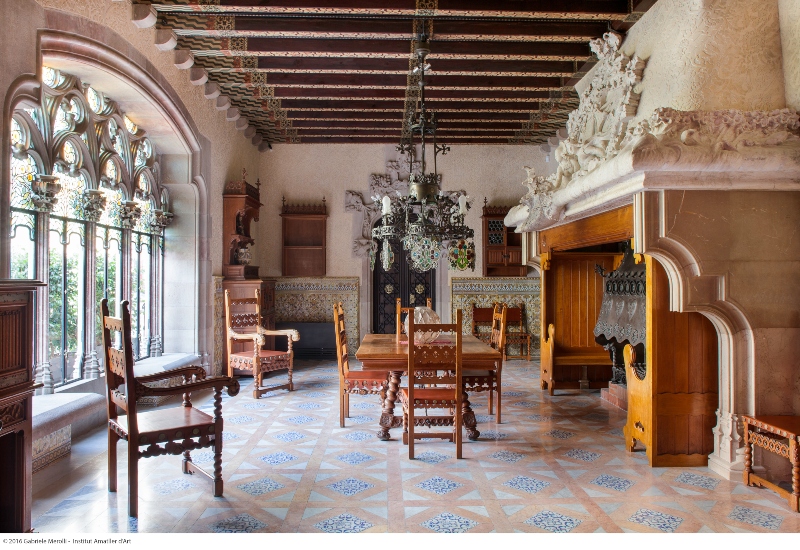
In 1878 phylloxera arrived in Catalonia. By then, many winemakers had diversified their businesses and had settled in more urban areas, so they are not so affected by this crisis in their economy. Yes, some territories where the dependence on wine was more direct suffered from the phylloxera plague. In the Alt Penedès, for example, they got rid of this terrible insect at the end of the 19th century, initiating a new stage of economic progress that coincided with the peak of modernism. Architects such as Puig i Cadafalch, known for having built the Casa Amatller in Barcelona, built the Cavas Codorniú in Sant Sadurní d'Anoia. Other architects of Catalan modernism also intervened in the construction of other wineries.
Therefore, Catalan wine and modernism are much more closely linked than they seem. So it's a good idea to celebrate Casa Museu Amatller's Modernist Nights with a glass of wine in its incredible surroundings. After a theatrical visit in which Teresa Amatller and her maiden propose a fascinating journey to a 1900 modernist house, is there a better ending than a delicious glass of wine?
The symbology of the façade of Casa Amatller
The façade of Casa Amatller is shown to passers-by on Passeig de Gracia in Barcelona as a beautiful icon of modernist architecture in Catalonia. The architect Josep Puig i Cadafalch presented an enormously original front that combines architectural solutions that reinterpret styles from Romanesque to Gothic. Not to mention the fascinating pediment that crowns the façade, with its triangular and staggered shape, inspired by the buildings of northern Europe.
But let us pay attention to the details of the façade, to its unique decorative elements of sculptures and sgraffito. The artisans of modernism put themselves at the service of Puig i Cadafalch to materialize a symbolic program that highlights the family of the owner and promoter of the work, the industrial chocolate maker Antoni Amatller. The sculptors Eusebi Arnau and Alfons Juyol were in charge of making the decorative pieces that populate the façade.
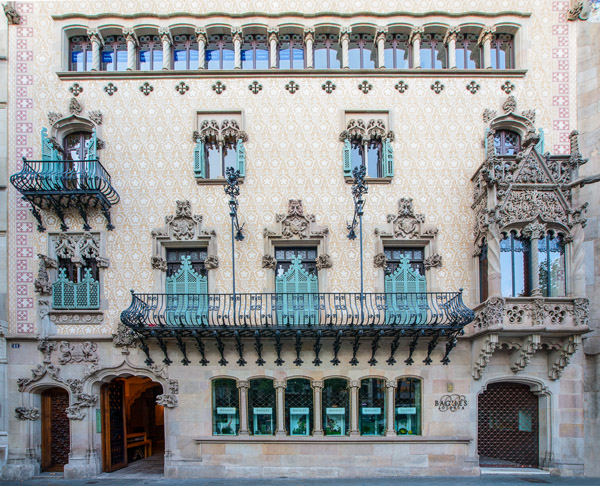
On the sides of the access doors is a gypsy who carries a tame bear tied with a rope, while on the other side is a beautiful lady fighting a beast. Between the two doors of Casa Amatller is a gentleman who kills a dragon, saving the long-haired princess who watches the scene from the main floor. The latter is a representation of Sant Jordi, patron saint of Catalonia. Antoni Amatller vindicates this, since, together with the architect Josep Puig i Cadafalch, he was closely linked to the Catalan cultural and political recovery movements of the Reinaxença: Sant Jordi is a symbol of Catalonia's reaffirmation.
In the other sculptural details of the access doors, above the arches, four characters can be observed that symbolize the arts: the painting, with a palette of colors in his hand; the sculpture, that holds a bust of a statue; the architecture, that observes a compass; and the music, making sound a harp. These four figures express Antoni Amatller's promotion of the arts, both when it comes to relying on architects, artists and contemporary craftsmen for the construction of his house, and when it comes to creating an excellent art collection.
To discover the activities that defined Antoni Amatller we have to take the view to the balcony of the main floor. Each of the three openings has on its lintel a shield with symbols of industry, arts and collecting. In the capitals of each side of the doors there are sculptures with animals that carry out human activities, specifying the meaning of the allegories.
On the left balcony, the coat of arms contains a compass, a knife, a hammer and a king's foot, accompanied by the figures of rabbits that melt iron and monkeys that he forges on the anvil. They refer to the industry that had allowed the fortune of the Amatller family.
The central balcony has a coat of arms with an open book and an old accordion camera, complemented by donkey writers with glasses and Cervantine lechuguilla around the neck and photographic dogs: they symbolise the arts. And they remember Antoni Amatller's activity as an amateur photographer, elevating it to the rank of art. Did you know that his studio was behind the triangular pediment of the façade?

On the right balcony the coat of arms frames glass and ceramic objects. In the sculptures we see frogs blowing glass and piglets working on ceramics. It is an allusion to the collection undertaken by Antoni Amatller, who specialised in the glass of the Antiquity, a collection that was continued until today, being one of the best in its genre.
There are still more allusions to Antoni Amatller: in the window of his bedroom there is a man with a box camera, remembering the chocolate maker's fondness for photography. On the other side of the window, a sculpture of an older woman watches over the princess mentioned in the episode of Sant Jordi. It could be some kind of celestine.
On the other hand, there is the allusion to the Amatller family. In the grandstand of Teresa Amatller's bedroom there is a large capital A, accompanied by more undersized A's. Together with the presence of the almond blossom (in Catalan "ametller"), and verses in which the flower of this tree is mentioned, it is a reference to the surname of the family, a successful generation of chocolatiers.
Finally, the flowers of the almond tree, with their characteristic five leaves, are regularly scattered throughout the façade: they are the sculptural finishing touches to the lines of window mouldings, but they are also present in the form of silkscreens on the colourful wall.
Casa Amatller has been shown since 1900 as a beautiful and fascinating building of Catalan modernism. However, thanks to reading the symbols on its façade, we know that it celebrates the success of Antoni Amatller's family as an industrial chocolate maker and as a great promoter of the arts. The work of the Catalan bourgeois families who started modernism thanks to their patronage is reinforced.





